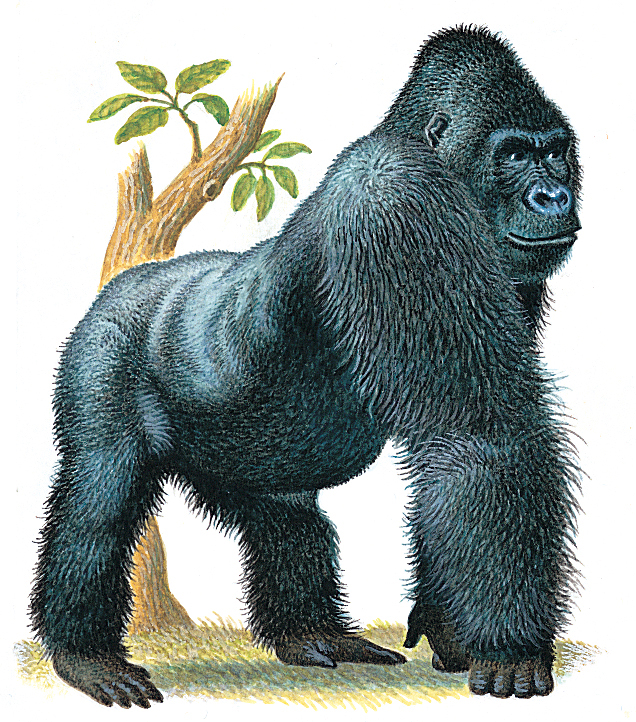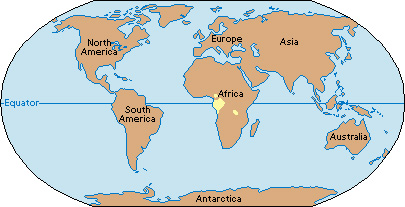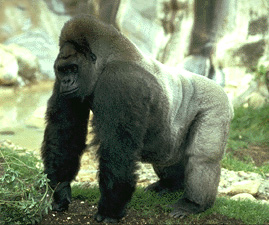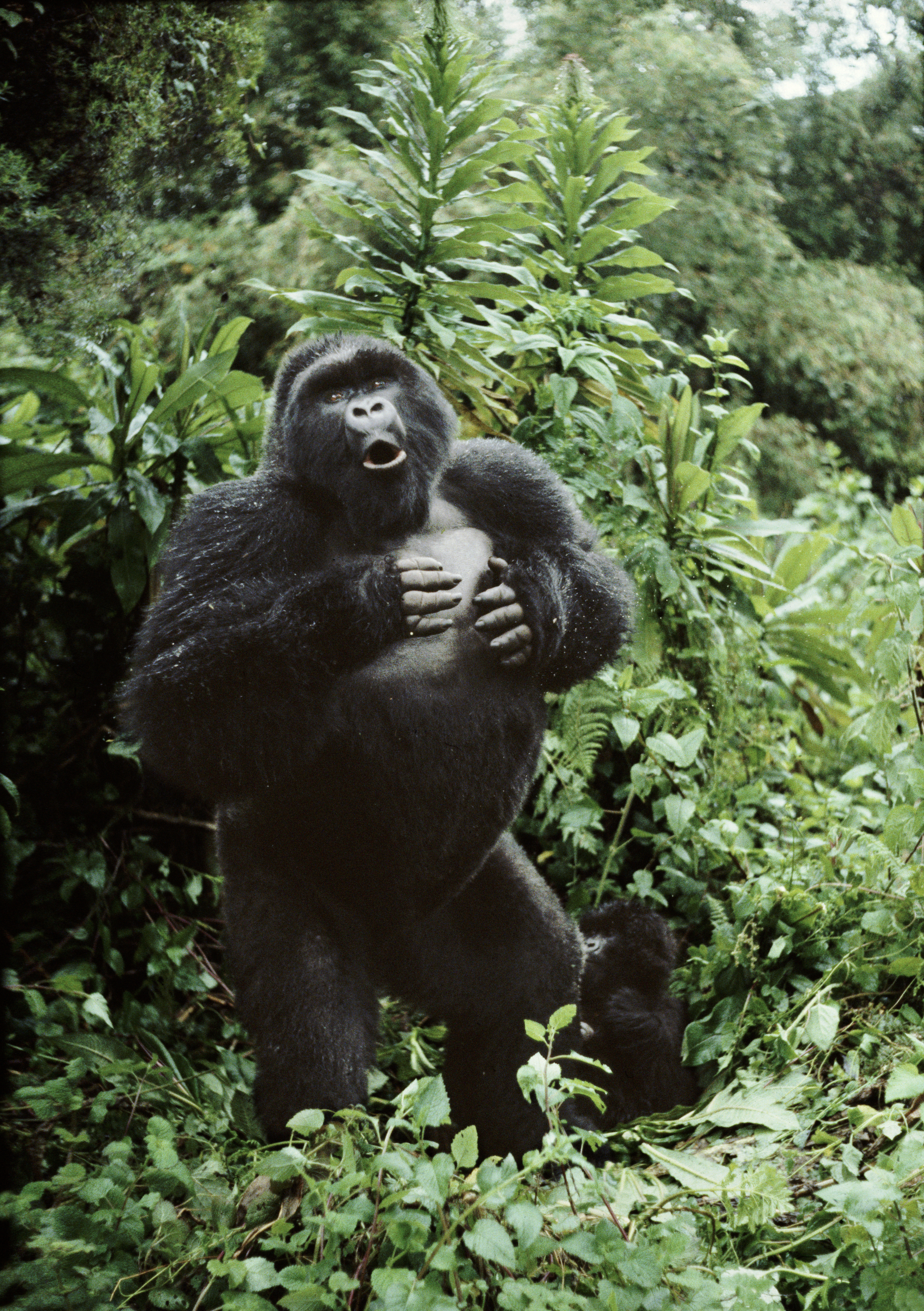Gorilla is the largest of the apes. It has huge shoulders, a broad chest, long arms, and short legs. A large male gorilla living in the wild may weigh 390 pounds (177 kilograms). Standing up on its legs, it may be 6 feet (1.8 meters) tall. Female gorillas are usually shorter, and they weigh about half as much as males. Gorillas, chimpanzees, and bonobos make up the group known as African apes, the closest relatives of human beings. There are four kinds of gorillas: the western lowland gorilla, the eastern lowland gorilla, the Cross River gorilla, and the mountain gorilla.
A gorilla looks fierce. It has a shiny black face, large canine teeth, and a thick ridge of bone above its eyes. Black or brownish hair covers all of its body, except its face, chest, palms, and the soles of its feet. The adult male gorilla has a hairy crest on its head and a grayish back. When a gorilla is excited or wants to drive off intruders, it stands up and slaps its hands against its chest. This produces a loud, threatening sound.
Actually, a gorilla is not as fierce as it looks. It will not hurt a human being unless it is threatened or attacked. Gorillas are shy, friendly animals that seem to need companionship and attention. The first gorillas kept in zoos did not live long, and some people believe they died from loneliness. Gorillas are not as outgoing as chimpanzees, and they are less eager to perform tricks.
Loading the player...Lowland gorillas
A gorilla usually walks on all fours, with its feet flat on the ground and its upper body supported on the knuckles of its hands. African apes are the only animals that walk exactly this way. A gorilla often stands up on its legs, but it travels only a few steps in this position. It sometimes climbs into trees to sit or eat.

Gorillas are quiet animals, though they can make about 20 different sounds. Angry males produce a startling roar. Babies whimper when distressed and scream if frightened. Adults grumble softly when contented. Gorillas have no enemies except human beings. People hunt gorillas for food and body parts, capture them for zoos, and cut down their forests. As a result, gorillas have become rare, and their survival is threatened. Today, fewer than 1,000 mountain gorillas and Cross River gorillas remain in the wild, and the numbers of western lowland gorillas and eastern lowland gorillas are decreasing.
The gorilla’s home
lies in the rain forests of Africa near the equator. The western lowland gorilla lives in the forests of western Africa, from Nigeria south to the Congo River. The eastern lowland gorilla lives in the eastern lowlands of the Democratic Republic of the Congo (DRC). The Cross River gorilla lives along the border of Cameroon and Nigeria. The mountain gorilla inhabits upland regions in Rwanda, the Virunga Mountains of the DRC, and mountain forests in Uganda. It lives at altitudes of up to 13,000 feet (3,960 meters), where the temperature is freezing at night.


Each group wanders around in its own home range, which is from 2 to 15 square miles (5 to 39 square kilometers). Gorillas never spend more than one night in the same place. Several groups may live in the same area of a forest, but they usually avoid one another.
The gorilla’s day
usually begins about an hour after sunrise. In the early morning, the apes feed on leaves, buds, barks, and fruits. Mountain gorillas eat herbs near the ground, while western lowland gorillas climb more to find ripe fruit. Only gorillas living in captivity eat meat.
Loading the player...Gorilla eating leaves
From the middle of the morning to the middle of the afternoon is nap time. The adults rest while the younger apes wrestle with each other, play games, and swing on vines. After the rest period, all the gorillas eat again.
Every evening just before dark, the gorillas build a simple nest where they sleep at night. They break or bend branches to make a crude platform, either on the ground or in trees. Adult gorillas build their own nests, but baby gorillas snuggle in with their mothers.
Life cycle.
The gorilla’s pregnancy lasts for from 8 to 9 months. The newborn gorilla is helpless. It weighs from 3 to 5 pounds (1.4 to 2.3 kilograms) at birth and remains with its mother for about 31/2 years. At first, the mother carries her baby by holding it to her chest. After about three months, the baby is strong enough to hold on by itself. It is able to crawl by the age of 3 months and walk by 5 months. But it usually rides “piggyback” until it is almost 3 years old. Then it travels by itself. 
Gorilla pounding chest and barking
Female gorillas usually mate when they are about 8 years old, and males reach full adulthood at about 12 years old. No one knows how long wild gorillas live. Some gorillas in captivity have lived up to 50 years. Most wild gorillas probably do not live as long. They suffer from diseases, especially those caused by parasites in the blood and intestines. Ebola virus outbreaks have killed many gorillas. They also may suffer from respiratory disorders and colds.
Gorillas in captivity.
The gorilla was not known to science until 1847. In 1911, the first gorilla was exhibited in a U.S. zoo. In 1956, Colo, the first gorilla born in captivity, was born in a zoo in Columbus, Ohio.
Gorillas rank among the most intelligent animals. In 1972, researchers at Stanford University began to teach sign language to a female gorilla named Koko. Koko learned several hundred signs and used them to communicate.

See also Ape; Chimpanzee; Fossey, Dian; Koko; Skeleton.
